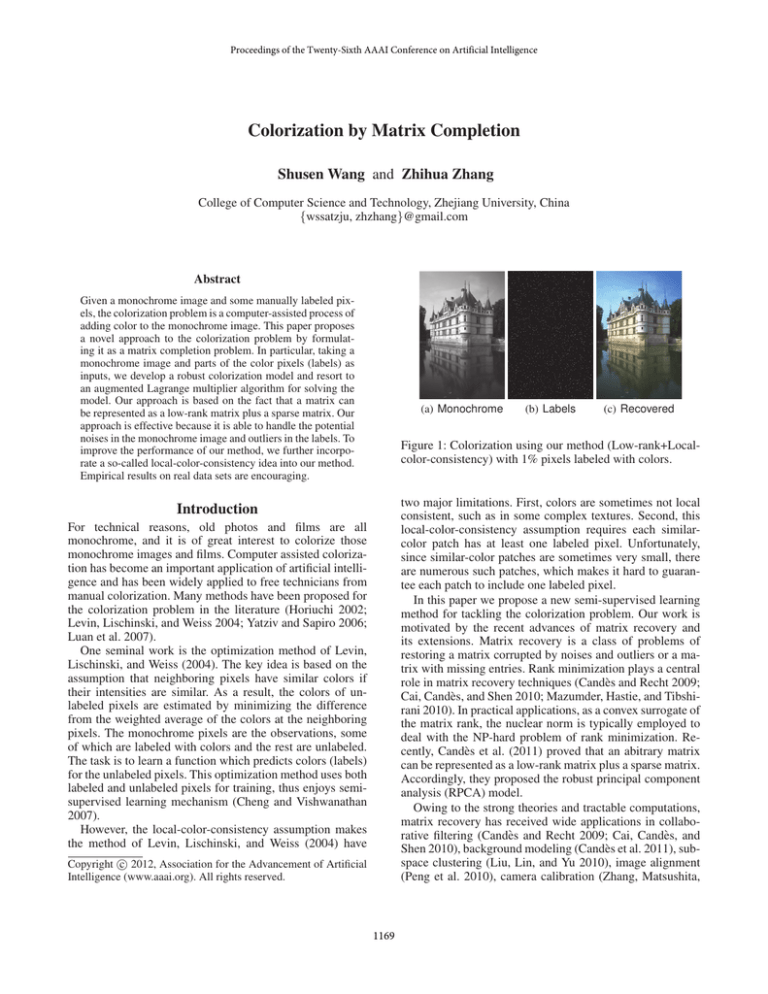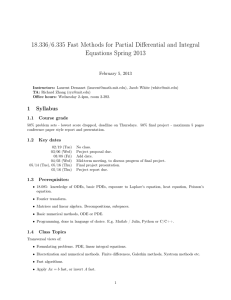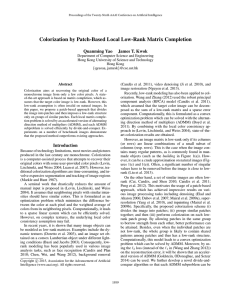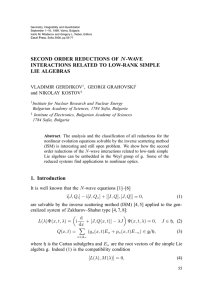
Proceedings of the Twenty-Sixth AAAI Conference on Artificial Intelligence
Colorization by Matrix Completion
Shusen Wang and Zhihua Zhang
College of Computer Science and Technology, Zhejiang University, China
{wssatzju, zhzhang}@gmail.com
Abstract
Given a monochrome image and some manually labeled pixels, the colorization problem is a computer-assisted process of
adding color to the monochrome image. This paper proposes
a novel approach to the colorization problem by formulating it as a matrix completion problem. In particular, taking a
monochrome image and parts of the color pixels (labels) as
inputs, we develop a robust colorization model and resort to
an augmented Lagrange multiplier algorithm for solving the
model. Our approach is based on the fact that a matrix can
be represented as a low-rank matrix plus a sparse matrix. Our
approach is effective because it is able to handle the potential
noises in the monochrome image and outliers in the labels. To
improve the performance of our method, we further incorporate a so-called local-color-consistency idea into our method.
Empirical results on real data sets are encouraging.
(a) Monochrome
(b) Labels
(c) Recovered
Figure 1: Colorization using our method (Low-rank+Localcolor-consistency) with 1% pixels labeled with colors.
two major limitations. First, colors are sometimes not local
consistent, such as in some complex textures. Second, this
local-color-consistency assumption requires each similarcolor patch has at least one labeled pixel. Unfortunately,
since similar-color patches are sometimes very small, there
are numerous such patches, which makes it hard to guarantee each patch to include one labeled pixel.
In this paper we propose a new semi-supervised learning
method for tackling the colorization problem. Our work is
motivated by the recent advances of matrix recovery and
its extensions. Matrix recovery is a class of problems of
restoring a matrix corrupted by noises and outliers or a matrix with missing entries. Rank minimization plays a central
role in matrix recovery techniques (Candès and Recht 2009;
Cai, Candès, and Shen 2010; Mazumder, Hastie, and Tibshirani 2010). In practical applications, as a convex surrogate of
the matrix rank, the nuclear norm is typically employed to
deal with the NP-hard problem of rank minimization. Recently, Candès et al. (2011) proved that an abitrary matrix
can be represented as a low-rank matrix plus a sparse matrix.
Accordingly, they proposed the robust principal component
analysis (RPCA) model.
Owing to the strong theories and tractable computations,
matrix recovery has received wide applications in collaborative filtering (Candès and Recht 2009; Cai, Candès, and
Shen 2010), background modeling (Candès et al. 2011), subspace clustering (Liu, Lin, and Yu 2010), image alignment
(Peng et al. 2010), camera calibration (Zhang, Matsushita,
Introduction
For technical reasons, old photos and films are all
monochrome, and it is of great interest to colorize those
monochrome images and films. Computer assisted colorization has become an important application of artificial intelligence and has been widely applied to free technicians from
manual colorization. Many methods have been proposed for
the colorization problem in the literature (Horiuchi 2002;
Levin, Lischinski, and Weiss 2004; Yatziv and Sapiro 2006;
Luan et al. 2007).
One seminal work is the optimization method of Levin,
Lischinski, and Weiss (2004). The key idea is based on the
assumption that neighboring pixels have similar colors if
their intensities are similar. As a result, the colors of unlabeled pixels are estimated by minimizing the difference
from the weighted average of the colors at the neighboring
pixels. The monochrome pixels are the observations, some
of which are labeled with colors and the rest are unlabeled.
The task is to learn a function which predicts colors (labels)
for the unlabeled pixels. This optimization method uses both
labeled and unlabeled pixels for training, thus enjoys semisupervised learning mechanism (Cheng and Vishwanathan
2007).
However, the local-color-consistency assumption makes
the method of Levin, Lischinski, and Weiss (2004) have
c 2012, Association for the Advancement of Artificial
Copyright Intelligence (www.aaai.org). All rights reserved.
1169
In this paper we consider RGB color images. Suppose the
color image is of size m×n and has three color components,
that is, red R̃, green G̃, and blue B̃, all of size m × n. The
corresponding monochrome image is the weighted sum of
the three components. There are two kinds of widely used
monochrome images: the average W = 13 (R̃ + G̃ + B̃) and
the luminosity W = 0.21R̃ + 0.71G̃ + 0.07B̃. Without loss
of generality, we use the average in our experiments.
Finally, the colorization problem is formally defined as
follows.
Definition 1. Suppose we are given a monochrome image
W ∈ Rm×n , a partially observed color image D ∈ Rm×3n ,
and a zero-one matrix Ω ∈ {0, 1}m×3n , where Ωij = 1
indicates Dij is observed and Ωij = 0 otherwise. The colorization problem is to obtain the three color components
R, G, B ∈ Rm×n which best approximate the underlying
R̃, G̃, B̃, respectively.
and Ma 2011), multi-label image classification (Cabral et al.
2011), etc. To the best of our knowledge, however, matrix
recovery has not yet been applied to colorization problem.
Typically, each color image can be represented by a matrix of the three color components. We thus seek to formulate
the colorization problem as a matrix completion problem (a
kind of matrix recovery problems). Roughly speaking, given
a proportion of observed entries from each color component
(i.e. labels) and the weighted sum of the three components
(the monochrome), colorization amounts to recovering the
matrix from the observations. In particular, our work offers
several contributions as follows.
1. Our work is the first to formulate colorization as a matrix
completion problem. On one hand, this enables us to apply recent advances in matrix completion to the colorization problem. On the other hand, our study brings some
new insight for the matrix completion problem.
2. Our approach is reasonable because it is based on the fact
that any natural image can be effectively approximated
by a low-rank matrix plus a sparse matrix (Cai, Candès,
and Shen 2010; Candès et al. 2011). And some recent developments (Candès and Recht 2009; Candès et al. 2011)
have even shown that low-rank matrices can be recovered
exactly from a small number of sampled entries under
some assumptions.
3. We develop a robust formulation which can handle the
noises in the monochrome image as well as the outliers in
the labels. Moreover, we devise an augmented Lagrange
multiplier (ALM) algorithm for solving the model. This
algorithm is very efficient; in all our experiments it performs less than 50 times singular value decompositions
even under extremely strong convergence criteria.
4. Finally, we show that the local-color-consistency idea can
be incorporated into our method, which further improves
the performance.
The rest of the paper is organized as follows. We first
formulate the colorization problem as a matrix completion problem and seek to solve it in a regularized rankminimization approach. We relax the rank-minimization
problem into a convex nuclear norm minimization problem,
providing a robust model as well as an algorithm for solving
the model. Then we propose to combine the low-rank and
local-color-consistency methods to improve colorization. Finally, we empirically demonstrate the performance of our
methods.
Methodology
Our methodology is motivated by the fact that a natural image matrix can be represented as sum of a low-rank matrix
and a sparse matrix. Thus it is intuitive to recover a lowrank matrix from the observations. From this point of view,
an optimization problem for colorization is naturally formulated as follows.
Let R, G and B ∈ Rm×n be the three color components
we would like to recover. By stacking them horizontally we
form L = [R, G, B] ∈ Rm×3n . Let S ∈ Rm×3n denote the
noises in the labels, W ∈ Rm×n the monochrome image,
D ∈ Rm×3n the labels, and Ω ∈ {0, 1}m×3n the indices of
the observed entries. Assuming that L is of low-rank and S
is sparse, we have
min
R,G,B,L,S
s.t.
rank(L) + λkΩ ◦ Sk0 ;
L = [R, G, B];
L + S = D;
α1 R + α2 G + α3 B = W,
(1)
1
3
where α1 = α2 = α3 = for the average monochrome
image and α1 = 0.21, α2 = 0.71, α3 = 0.07 for the luminosity. The third constraint is equivalent to LT = W where
T = [α1 In , α2 In , α3 In ]T .
With these notations, Problem 1 can be equivalently expressed as follows.
min rank(L) + λkΩ ◦ Sk0 ; s.t. L + S = D; LT = W. (2)
Problem Formulation
L,S
First of all, we give some notations that will be used in
our paper. For a matrix A = [Aij ] ∈ Rm×n , let kAk0
be the `0P
-norm (i.e. the number of nonzero entries
of A),
P
kAk1 = i,j |Aij | be the `1 -norm, kAkF = ( i,j A2ij )1/2
be
PrFrobenius norm, kAk∞ = maxi,j |Aij |, and kAk∗ =
i=1 σi (A) be the nuclear norm where r = min{m, n}
and σi (A) is the i-th largest singular value of A. Additionally, let A ◦ B be the Hadamard product of A and B, i.e.
A ◦ B = [Aij Bij ]. Finally, let Im denote the m × m identity
matrix.
Since the regularized rank-minimization problem 2 is NPhard, in most matrix recovery problems the nuclear norm
and `1 -norm are often used as surrogates of matrix rank and
the `0 -norm, respectively. We relax Problem 2 into Problems 3 of
min kLk∗ + λkΩ ◦ Sk1 ; s.t. L + S = D; LT = W. (3)
L,S
Taking into account the potential noises in the input
monochrome image W, we formulate Problem 3 in a more
1170
Figure 2: Combine low-rank method and local-color-consistency method.
Algorithm 1 The ALM Algorithm
follows.
1: Input: W, D and Ω, parameters λ and η.
(0)
(0)
2: j = 0; Y1 = Y2 = sgn(D)/ max kDk2 , kDk∞ /λ ;
(0)
(0)
L(0) = 0; S(0) = 0; X(0) = 0; µ1 > 0; µ2 > 0; ρ > 1;
T
T = [α1 In , α2 In , α3 In ] ;
3: repeat
(j)
(j)
(j)
(j)
Y1 +Y2 +µ1 (D−S(j) )+µ2 X(j)
4:
ZL ←
;
(j)
(j)
µ1 +µ2
(j+1)
5:
L
←S
ZL ;
(j)
(j)
1
6:
7:
min
L,S,X
s.t.
1
µ1 +µ2
(j)
10:
(j)
(j)
∂LX
= X(j) (ηTTT + µ2 I) − ηWTT + Y2
∂X
(j) (j+1)
;
µ2 L
X
X(j+1) ← solution to ∂L
∂X
= 0;
(j+1)
(j)
(j)
Y1
← Y1 + µ1 D − L(j+1) − S(j+1) ;
11:
Y2
9:
(j+1)
(j+1)
η
= kLk∗ + λkS ◦ Ωk1 + kXT − Wk2F
2
µ1
+ < Y1 , D − L − S > + kD − L − Sk2F
2
µ2
+ < Y2 , X − L > + kX − Lk2F .
2
(j)
(j)
(j+1)
← ρµ1 ; µ2
12:
µ1
13: until convergence
14: Output: L(j+1) and S(j+1) .
−
X(j+1) − L(j+1) ;
(j)
← Y2 + µ2
(j)
← ρµ2 ;
j ← j + 1;
min kLk∗ + λkS ◦ Ωk1 + η2 kLT − Wk2F ;
L,S
L + S = D.
(6)
The ALM algorithm solves Problem 5 by alternately minimizing the augmented Lagrange function w.r.t. L, S, X and
maximizing w.r.t. Y1 and Y2 . This procedure is shown in
Algorithm 1, and the derivation is elaborated in Appendix.
In each iteration the ALM algorithm solves a regularized
nuclear norm minimization problem w.r.t. L. We resort to the
singular value shrinkage operator defined in (Cai, Candès,
and Shen 2010). For τ ≥ 0, the singular value shrinkage
operator Sτ is defined as
Dτ (A) ij = sgn(Aij )(|Aij | − τ )+ ,
robust form:
s.t.
(5)
L(L, S, X, Y1 , Y2 )
1
8:
L + S = D;
L = X.
We solve Problem 5 by the augmented Lagrange multiplier (ALM) algorithm (Lin et al. 2009). The corresponding
augmented Lagrange function is
+ D(j) − L(j+1) ;
(j) Y1
µ1
S(j+1) ← Ω ◦ Dλ/µ(j) ZS + Ω̄ ◦ ZS ;
ZS ←
kLk∗ + λkS ◦ Ωk1 + η2 kXT − Wk2F ;
(4)
Sτ (B)
T
= UB Dτ (ΣB )VB
,
(7)
T
where B = UB ΣB VB
is the singular value decomposition (SVD) of B. The optimality of Dτ and Sτ is shown in
Proposition 2 in Appendix.
With this robust formulation, we are able to handle the data
noises in the monochrome image and the outliers in the labels. Thus, we define colorization as Problem 4 and we are
concerned with its solution.
It is worth mentioning that although our model has two
tuning parameters, selecting the parameters is not troublesome at all. We will show later that our method is indeed not
very sensitive to the parameters. In particular, we prespecify
the parameters to be λ = η = 10 in all the experiments.
Remark: The computation cost of Algorithm 1 in each iteration is dominated by the SVD in Line 5. Our off-line experiments show that the algorithm gets convergence in less than
50 iterations, i.e. performs less than 50 SVDs, for images of
all small and large sizes (from 150 × 200 to 1500 × 2000
pixels).
Solution
Combining Low-rank and Local-color-consistency
Methods
In order to solve Problem 4, a slack matrix X ∈ Rm×n is
introduced to decouple the terms containing L in the objective function. The problem is then equivalently defined as
In the experiments we notice that our low-rank method
works well when there are sufficient labeled pixels,
but the performance deteriorates with the decreasing of
1171
(a) Original (b) LR 10% (c) LL 10% (d) LR 1% (e) LL 1%
(a) R 20% (b) R 30% (c) R 50% (d) LR 10% (e) LL 1%
Figure 3: Figure (b) (d) are computed by the Low-Rank (LR)
method and (c) (e) by Low-rank+Local-color-consistency
(LL) method. The percentage denotes the proportion of labeled pixels.
Figure 4: Figure (a) (b) (c) are computed by RPCA (without exploiting monochrome image) with 20%, 30%, and
50% pixels labeled; Figure (d) (e) are computed respectively
by our Low-Rank (LR) method and Low-rank+Local-colorconsistency (LL).
labeled-pixel proportion. On the contrary, the local-colorconsistency method (Levin, Lischinski, and Weiss 2004) is
less sensitive to the labeled-pixel-proportion. This motivates
us to combine the advantages of the low-rank method and
local-color-consistency method.
Our intuition is to make use of local-color-consistency
along with the robustness of our low-rank method to improve colorization ability. First, for each unlabeled pixel
(i, j), we find all its neighboring labeled pixels with
monochrome intensity close to pixel (i, j), and then label
pixel (i, j) with the weighted sum of those labeled neighbors. The weight should be positively correlated with their
intensity similarity and negatively correlated with their distance. Notice that some pixels are still unlabeled and some
may be incorrectly labeled after this process; this problem
can be handled by our robust low-rank method. By taking
these labels as well as the initially given labels as inputs, the
low-rank method can complete the colorization. This procedure is illustrated in Figure 2.
The comparison of the low-rank method and lowrank+local-color-consistency method is shown in Figure 3.
The results clearly show that the low-rank+local-colorconsistency method still works well even if very few labeled
pixels are given, while the low-rank method fails. Since the
low-rank+local-color-consistency method performs significantly better than the low-rank method, in the next sections
we mainly compare our low-rank+local-color-consistency
with the local-color-consistency method of Levin, Lischinski, and Weiss (2004).
Problem 8 by assuming the potential data noises are sparse:
min kLk∗ + λkΩ ◦ Sk1 ;
L
Experiments
In this section we carry out a set of experiments on natural
images to demonstrate the performance of our method. We
also conduct comparison with the method of Levin, Lischinski, and Weiss (2004), which we will denote by LLW for
description simplicity. The sample images that we used are
shown in Figure 5. Recall that the monochrome image is defined as a weighted sum of the R, G, and B components.
Without loss of generality, we average the three components
to obtain the monochrome image.
The first set of experiments are conducted on all the sample images in Figure 5 to measure the image recovery accuracy. The monochrome image is obtained by averaging the
R, G, and B components. We randomly hold a certain percentage of pixels (uniformly) of the original image as the
observed part (labels). Using the monochrome image and
the labels, we run our two methods and the LLW method
for comparison. We define the relative square error (RSE) to
measure the recovery accuracy:
In this section we discuss the connection of our method with
existing matrix completion methods. We show that the colorization problem is a matrix completion problem with an
additional regularization term. With this term, the matrix
completion problem can be solved much more accurately.
Candès and Recht (2009) proposed to solve the matrix
completion problem via the following convex optimization
model:
L
s.t. Ω ◦ (L − D) = 0.
(9)
which is well known as the RPCA model. With an additional
regularization term kLT−Wk2F , the RPCA model becomes
Problem 4.
Given a monochrome image, i.e. the average of the three
components in our case, we can add an extra regularization term to the matrix completion problem formulation,
with which the matrix recovery accuracy is significantly improved. Figure 4 gives a comparison of matrix completion
results with and without exploiting the monochrome image.
The results clearly demonstrate that with the information of
the monochrome image encoded in our model, the matrix
completion problem is solved much more accurately.
Our work suggests that the matrix completion formulation 9 is extensible; with encoding some other knowledge
than the given entries, the matrix completion accuracy can
be largely improved.
Related Work
min kLk∗ ;
s.t. L + S = D,
(8)
RSE =
Later on, Candès et al. (2011) formulated a robust version of
1172
kL∗ − [R̃, G̃, B̃]kF
,
k[R̃, G̃, B̃]kF
(a)
(b)
(c)
(d)
(e)
(f)
(g)
(h)
Figure 5: Sample images from the Berkeley Segmentation Dataset (Martin et al. 2001).
(a) LL, 0.1%
(b) LLW, 0.1%
(c) LL, 1%
(d) LLW, 1%
(e) LL, 10%
(f) LLW, 10%
Figure 6: Results of colorization using our Low-rank+Local-color-consistency (LL) method and the method of Levin, Lischinski, and Weiss (2004) (LLW). The percentage of each figure denotes the proportion of labeled pixels.
Future Work
where R̃, G̃ and B̃ are the three color components of original image while L∗ is the recovered image obtained by each
colorization method. The RSE versus labeled-pixel proportion of each sample image is shown in Figure 7. We also
present visual comparisons between our low-rank+localcolor-consistency (LL) method and LLW in Figure 6. Although these two methods can recover the color given sufficient labels, a detailed look at the recovered images reveals
differences in intensity, illumination, and some other details.
The visual results and the RSEs all demonstrate that the
images restored by our Low-rank+local-color-consistency
method are closer to the original image.
As aforementioned, our low-rank method requires sufficient
labeled pixels (say more than 10%) as inputs, thus we seek to
improve the performance via a preprocessing step to generate more labels as inputs for our low-rank method. Although
the generated labels are potentially noisy, it does not hurt the
performance because our low-rank method is very robust.
We have successfully employed the local-color-consistency
method of Levin, Lischinski, and Weiss (2004) to generate more labels, and the performance has been significantly
escalated. Similarly, other approaches can also be incorporated in the same way. For example, we can make use of the
color labeling scheme proposed by Luan et al. (2007) which
groups not only neighboring pixels with similar intensity but
also remote pixels with similar texture.
Moreover, an improvement can be made to deal with the
generated labels. Since the generated labels are potentially
more noisy, we can discriminate between the generated labels and the original labels by reformulating Problem 4 as
In the second set of experiments, we manually label some
pixels of the monochrome images with corresponding colors. We show in Figure 9 the results obtained by each
method from two manually labeled images: one with few
but relatively correct labels, the other with many noisy labels. From the results we can see that our two methods are
more robust than the LLW method.
min kLk∗ + λ1 kS ◦ Ω1 k1 + λ2 kS ◦ Ω2 k1
L,S
Finally, we demonstrate that our low-rank method is insensitive to the tuning parameters λ and η of Problem 4. We
use the image in Figure 5(a) with 1%, 5%, and 10% pixels being labeled respectively as the input of our method;
with one parameter fixed while the other varies, we plot the
RSE against the parameter value in Figure 8. Our off-line experiments on a variety of images, small and large sizes, all
demonstrated that our method is insensitive to λ and η. From
150 × 200 small images up to 1500 × 2000 large images, the
results of simply setting λ = η = 10 are always quite near
those obtained by carefully tuning the two parameters.
s.t.
+ η2 kLT − Wk2F ;
L + S = D,
(10)
where the original labels are indexed by Ω1 and the generated labels by Ω2 , and λ1 > λ2 > 0.
Finally, our method can also be applied to video colorization and batch image colorization, as well as single image colorization. Such tasks can be fulfilled by stacking the
video frames or a batch of images together as a single image
followed by colorizing the stacked image. This approach is
reasonable because it exploits the similarity among the related frames or images.
1173
Conclusions
(a) image 5a
In this paper we have proposed a matrix completion approach to the colorization problem. Our proposal is built
on the robust principal component analysis idea. In particular, we have formulated colorization as a convex optimization problem and devised an augmented Lagrange multiplier
algorithm to solve the optimization problem. Our approach
is flexible because it can be combined with the local-colorconsistency leading to better colorization results. The experiments have demonstrated that our method can produce better performance in comparison with the existing state-of-art
method.
(b) image 5b
Acknowledgments
This work is in part supported by the Natural Science Foundations of China (No. 61070239).
(c) image 5c
References
(d) image 5d
(e) image 5e
(f) image 5f
(g) image 5g
(h) image 5h
Cabral, R.; De la Torre, F.; Costeira, J.; and Bernardino, A.
2011. Matrix completion for multi-label image classification. In Advances in Neural Information Processing Systems.
Cai, J.-F.; Candès, E.; and Shen, Z. 2010. A singular value
thresholding algorithm for matrix completion. SIAM Journal on Optimization 20(4):1956–1982.
Candès, E., and Recht, B. 2009. Exact matrix completion via
convex optimization. Foundations of Computational Mathematics 9(6):717–772.
Candès, E.; Li, X.; Ma, Y.; and Wright, J. 2011. Robust
principal component analysis. Journal of the ACM 58(3).
Cheng, L., and Vishwanathan, S. 2007. Learning to compress images and videos. In Proceedings of the 24th international conference on Machine learning, 161–168. ACM.
Horiuchi, T. 2002. Estimation of color for gray-level image by probabilistic relaxation. In Proceedings of the 16 th
International Conference on Pattern Recognition.
Levin, A.; Lischinski, D.; and Weiss, Y. 2004. Colorization using optimization. In ACM Transactions on Graphics
(TOG), volume 23, 689–694. ACM.
Lin, Z.; Chen, M.; Wu, L.; and Ma, Y. 2009. The augmented
lagrange multiplier method for exact recovery of corrupted
low-rank matrices. UIUC Technical Report, UILU-ENG-092215.
Liu, G.; Lin, Z.; and Yu, Y. 2010. Robust subspace segmentation by low-rank representation. In The 17th International
Conference on Machine Learning.
Luan, Q.; Wen, F.; Cohen-Or, D.; Liang, L.; Xu, Y.-Q.; and
Shum, H.-Y. 2007. Natural image colorization. In Rendering
Techniques 2007 (Proceedings Eurographics Symposium on
Rendering). Eurographics.
Martin, D.; Fowlkes, C.; Tal, D.; and Malik, J. 2001. A
database of human segmented natural images and its application to evaluating segmentation algorithms and measuring
ecological statistics. In The 8th International Conference on
Computer Vision.
Figure 7: Relative square errors (RSE) of colorization using
the three methods on the sample images in Figure 5.
(a) η = 10
(b) λ = 10
Figure 8: Relative square errors (RSE) of the low-rank
method versus the tuning parameters λ and η of Problem 4.
1174
(a) Monochrome
(b) Manual labels
(c) LLW
(d) LR
(e) LL
Figure 9: Colorization with manually labeled color solved by our Low-Rank (LR) method, Low-rank+Local-color-consistency
(LL) method, and the method of Levin, Lischinski, and Weiss (2004) (LLW).
matrix whose the (i, j)-th entry is 1 − Ωij , then the solution
to the following optimization problem
1
 = argmin τ kA ◦ Ωk1 + kA − Bk2F .
2
A
Mazumder, R.; Hastie, T.; and Tibshirani, R. 2010. Spectral regularization algorithms for learning large incomplete
matrices. Journal of machine learning research 11(2):2287–
2322.
Peng, Y.; Ganesh, A.; Wright, J.; Xu, W.; and Ma, Y. 2010.
Rasl: Robust alignment by sparse and low-rank decomposition for linearly correlated images. In IEEE Conference on
Computer Vision and Pattern Recognition.
Yatziv, L., and Sapiro, G. 2006. Fast image and video colorization using chrominance blending. IEEE Transactions
on Image Processing 15(5):1120–1129.
Zhang, Z.; Matsushita, Y.; and Ma, Y. 2011. Camera calibration with lens distortion from low-rank textures. In IEEE
Conference on Computer Vision and Pattern Recognition.
is  = Ω ◦ Dτ (B) + Ω̄ ◦ B.
The augmented Lagrange function of Problem 5 is shown
in Equation 6. In the augmented Lagrange function the terms
containing L is LL :
µ1 + µ2
kL − ZL k2F ,
(13)
LL = kLk∗ +
2
1
Y1 + Y2 + µ1 (D − S) + µ2 X (14)
.
ZL =
µ1 + µ2
Optimizing LL w.r.t. L lead to the solution S1/(µ1 +µ2 ) (ZL ),
as guaranteed by Proposition 2.
The terms containing S is LS :
µ1
LS = λkS ◦ Ωk1 +
kS − ZS k2F ,
(15)
2
1
ZS =
Y1 + D − L.
(16)
µ1
Optimizing LS w.r.t. S lead to the solution Ω◦Dλ/µ1 (ZS )+
Ω̄ ◦ ZS , as guaranteed by Proposition 3.
The terms containing X is
η
µ2
LX = kXT − Bk2F + < Y2 , X − L > + kX − Lk2F .
2
2
The derivative of LX w.r.t. X is
∂LX
= X(ηTTT + µ2 I) − ηWTT + Y2 − µ2 L,
∂X
setting which to zero leads to the optimal value of X. This
linear system can be solved efficiently by the conjugate gradient algorithm.
Derivation of Algorithm 1
The optimality of Sτ is shown in Proposition 2, which
guarantees the optimality of minimizing the augmented Lagrange function (6) w.r.t. L.
Proposition 2. For any τ ≥ 0, A, B ∈ Rm×n , Dτ and Sτ
defined in (7) obey
1
Dτ (B) = argmin τ kAk1 + kA − Bk2F ,
2
A
1
Sτ (B) = argmin τ kAk∗ + kA − Bk2F .
2
A
(11)
(12)
Based on Equation (11), we give a similar result in Proposition 3 which guarantees the optimality of minimizing (6)
w.r.t. S.
Proposition 3. Given any τ ≥ 0, A, B ∈ Rm×n , Ω ∈
{0, 1}m×n . Let Dτ be defined in (7) and Ω̄ be an m × n
1175








